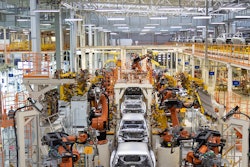
If you're in the retail business, one of your worst nightmares is being stuck with boxes and boxes of unsold inventory taking up space in the warehouse. Wasted stock can be a huge cost to the bottom line and pose serious risks to your business.
For eco-conscious brands, a lot of unsold inventory is also detrimental to the environment, especially if the products are textile-based. Of the more than 100 billion items of clothing produced each year, some 20% go unsold, and leftovers are usually buried, shredded or incinerated.
Businesses that end up in an overstock situation generally use traditional bulk manufacturing, which requires products to be made and then warehoused until they are shipped. While there is a risk of costly unsold inventory, bulk production can also be economically effective if a product is proven to be a best-seller.
On the opposite side of the spectrum sits on-demand manufacturing, a process by which goods are produced only when needed and in the quantities required, eliminating the cost and effort of storing and managing inventory. Although on-demand products are not produced at economies of scale, businesses can more easily and quickly test and go to market with new products and designs.
Previously, businesses would need to choose one method or the other, but with recent advancements in technology in the past decade, retailers can get the best of both worlds through hybrid manufacturing. An economically and environmentally sustainable solution, a hybrid approach blends the cost-effectiveness of bulk production with the risk-free per-order fulfillment process of on-demand manufacturing.
How hybrid works
Before adding any new item to product lines, experts recommend testing them through on-demand manufacturing to ensure viability. An on-demand approach gives retailers the freedom to sell more SKUs and products that might not take off en masse. Once retailers know a product has the potential to move into mass production, the switch can be made. Eventually, when interest wanes and the product becomes more evergreen but to a smaller audience, retailers can realize ongoing value by going back to an on-demand approach.
It’s important to find the right mix of on-demand products and bulk inventory in order to optimize sales.
Why utilize a hybrid approach
● Adapt to trends quickly without risk. Culture is now manufactured on-demand. In the past, consumer trends were generally set by businesses. However, in the recent decade, the tables have turned and consumers are setting trends on social media. Because buyers are now changing the way we capitalize on culture, it is affecting how brands produce and manufacture products on-demand. With a hybrid approach, brands can quickly mock-up a design and add the product to their online store without prepaying for costly order minimums by first using on-demand manufacturing. If the product doesn’t fly off the shelf, then you can simply remove it from your store and not have to worry about piles of unsold inventory. If it proves to be successful, then they can switch the production process to bulk manufacturing.
● Improve cash flow. When a business utilizes a blend of on-demand and bulk manufacturing for its products, it can more easily optimize its cash flow. For bulk products, they can get a higher per product profit margin due to economies of scale. For on-demand products, they don’t have to pay for costly inventory or order minimums, freeing up a business’s cash flow. This liquidity allows brands to boost revenue-driving activities such as marketing, which increase sales, and ultimately grows their business.
● Shift toward sustainability. Being eco-conscious is no longer a consumer marketing trend, it is a real practice many businesses are implementing in their business model. Because on-demand manufacturing allows companies to produce only what consumers order, it eliminates unnecessary production and harmful waste—saving both the business’s bottom line and the environment.
● Be better prepared for economic disruptions. When the Coronavirus disease (COVID-19) disrupted supply chains across all industries last year, many retailers were forced to shut down and were left with boxes of unsold inventory. When utilizing on-demand manufacturing in a hybrid approach, it is important to look for a provider that manages a distributed supply chain network. This type of fulfillment process allows on-demand manufacturing providers the ability to carry a large number of product SKUs in more than one facility, therefore orders of that product are able to be fulfilled in multiple locations. That means if one location closes or has an external disruption— they can seamlessly move order fulfillment to another facility.
It has never been easier to embrace a hybrid manufacturing approach. Many retailers can use traditional manufacturing for bulk products that sell all year round in conjunction with on-demand for short-term collaborations and innovative, trending designs. Because on-demand doesn’t require a large amount of startup capital, it is a low-risk method that can lead to high returns. The ease and efficiency of on-demand combined with the cost-effectiveness of traditional manufacturing is truly paving the way for the future of sustainable retail.















